Blog
July 15th, 2015

Because we’re having a record-hot summer this year, everything is coming into season early. And it’s all ripening at once, which made us look at the shelf of canning jars in panic.

But there was nothing for it but to dive in and start filling jars (and jars and jars).
August 20th, 2013

It’s the time of year where our kitchen is a lot hotter—and the days much longer—than anything summer might throw at us naturally.
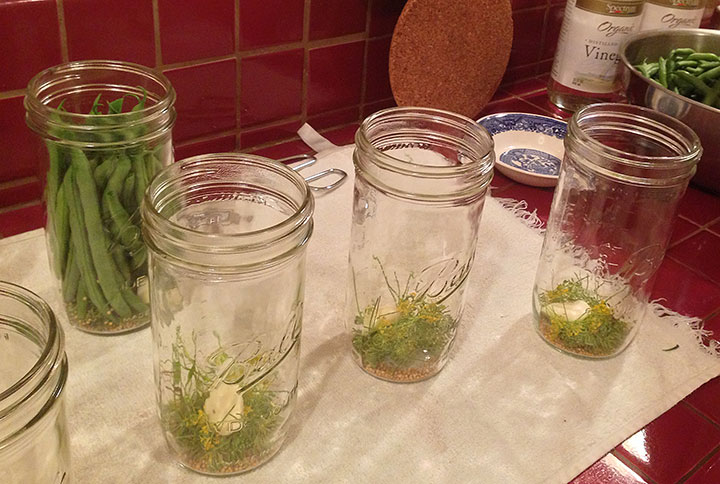
The Tailor and I have been up late with the dilly beans,


out at dawn at the Blueberry Park,
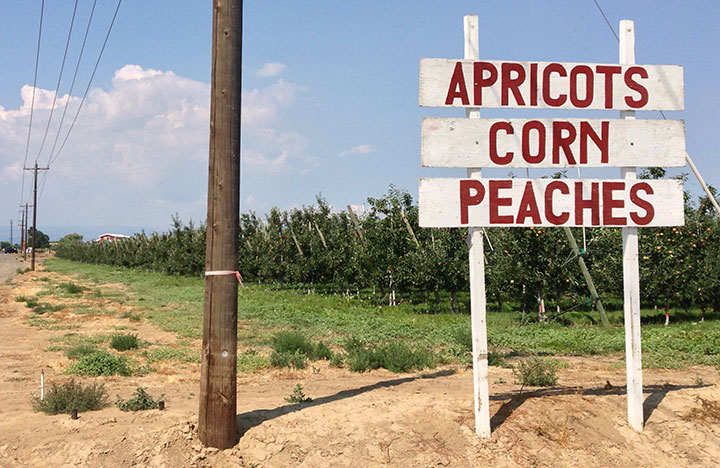
and across the mountains to get peaches right off the tree.

And then everything has got to get washed and sliced—

—and packed into jars—as quickly as possible. It’s the best way we know how to make the fleeting summer last.
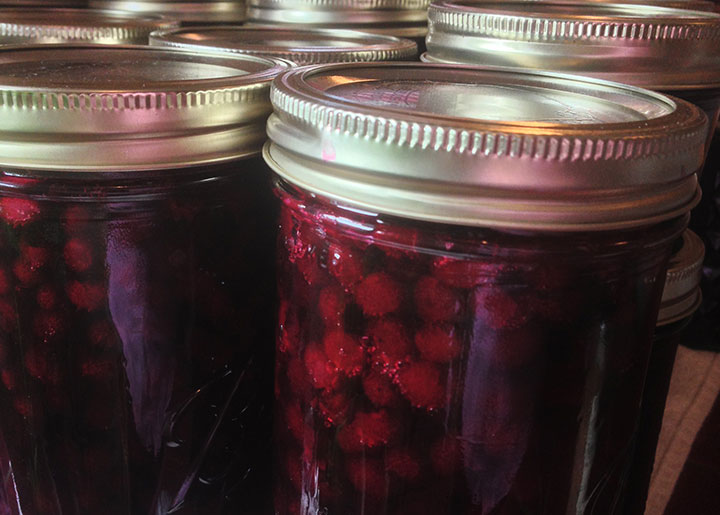
July 20th, 2012
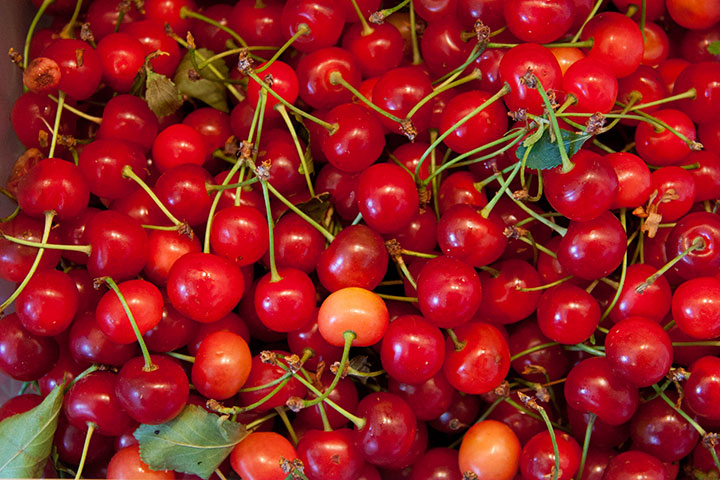
Picture a Chuck-E-Cheese-ball-pit-sized vat of pie cherries: that’s what our kitchen feels like right now.
The Tailor loves fresh sour pie cherries with a fiery passion, but they don’t grow well in western Washington (not enough sun). And they’re both hard to transport commercially (thin skins) and not super popular with folks under the age of 80 (too much work). So as you can imagine, even though home canning is a big part of everyday life around our house, he hadn’t been able to add cherries to the routine.
Until now.

He managed to find a farmer on the other side of the mountains who specialized in pie cherries. To make it worthwhile for both the farmer to harvest them fresh, and the Tailor to drive three hours one way, he ordered a metric boatload.
So now our kitchen is filled with pitted cherries.
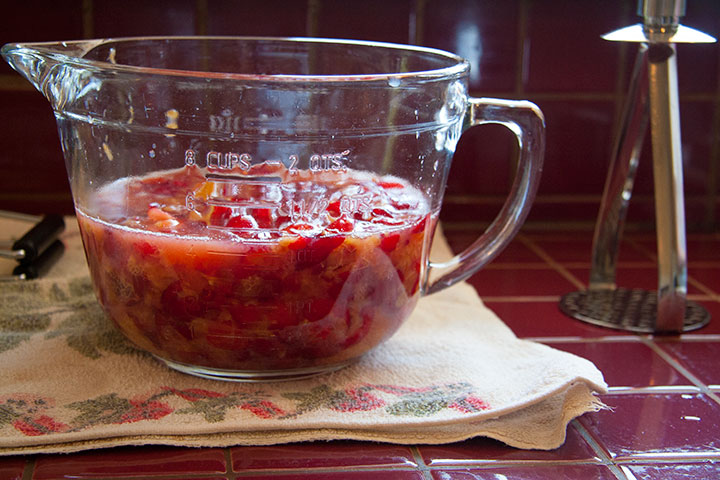
And mashed cherries.
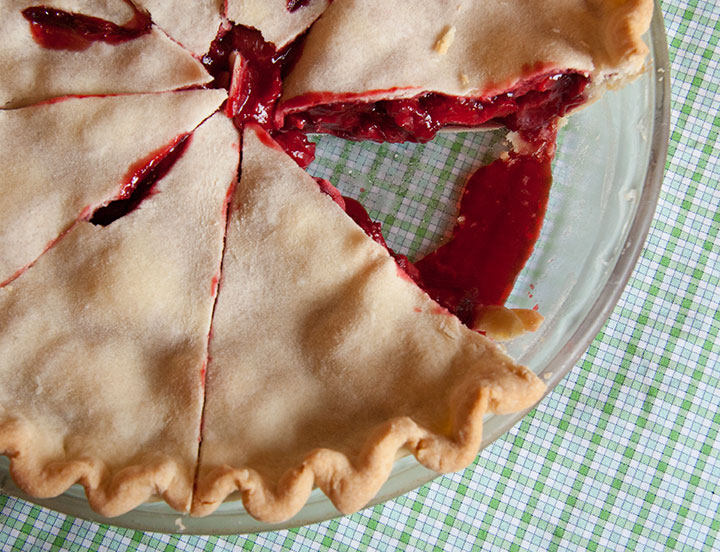
And pie’d cherries.
I gotta say—I finally see what all the fuss is about! That is one tasty labor of love.
October 4th, 2010
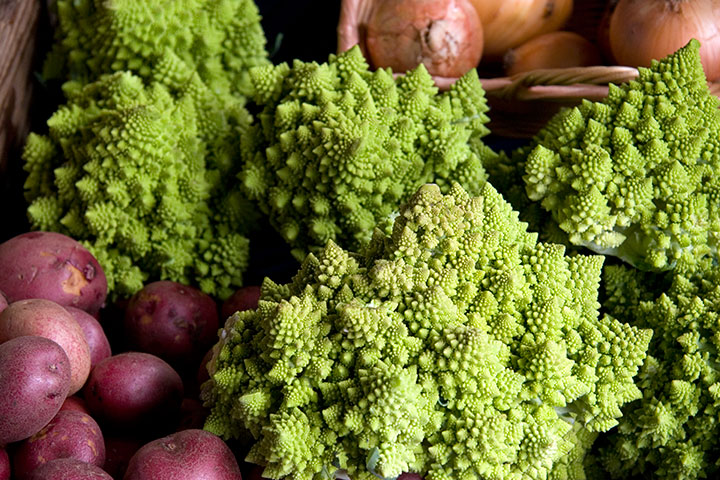
Somehow I’ve managed to tear myself away from the massive pile of drawings a couple of times in the past two weeks—once for a quick trip to the wonderful Olympia Farmers Market to pick up a few things. (Look, fractal geometry!)
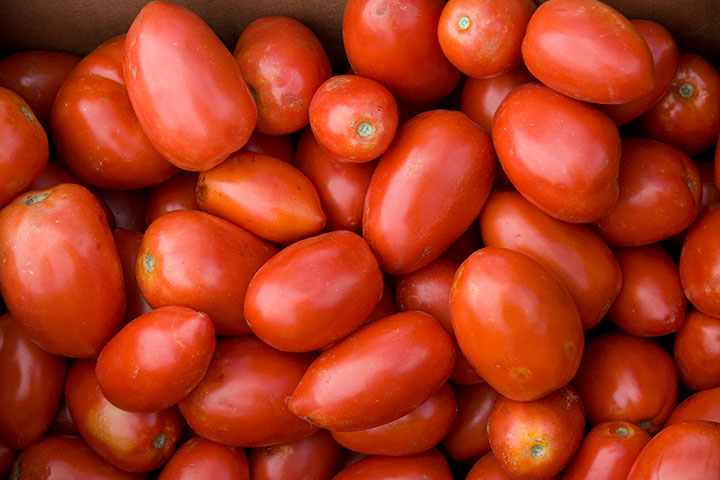
Okay, maybe “few” is stretching the truth a bit, since one of those items was fifty pounds of organic romas, destined for tomato sauce. These babies are a month late, and we’re lucky to have them at all. It’s been a dismal summer for tomato growers here—but hey, it’s nice to have that one last bit of summer when you can get it.
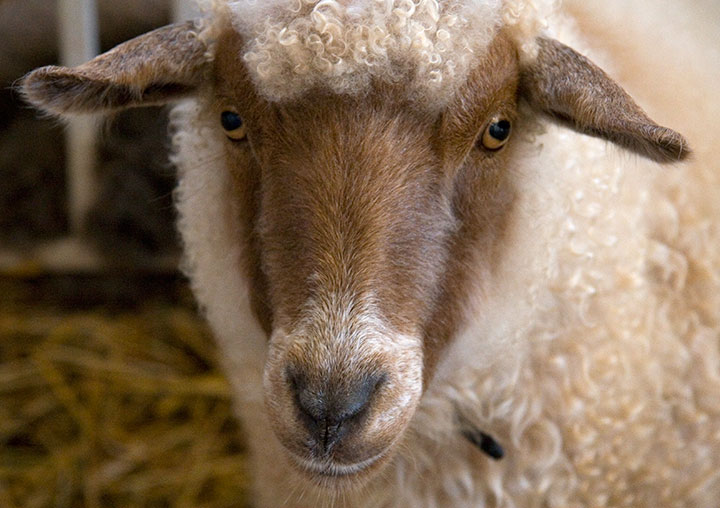
The other time was for a little taste of the winter to come—at the Oregon Flock & Fiber Festival. The place had me dreaming of winter silence and warm, woolly sweaters.
Maybe if we hurry up and can those tomatoes, sweater weather will come faster!
August 15th, 2010

Earlier this month, my best friend Elizabeth flew in for a visit. Each time she’s come to town I’ve taken her to see a different part of the state—and since we’re in the middle of fruit season, this time we headed for the Yakima Valley.
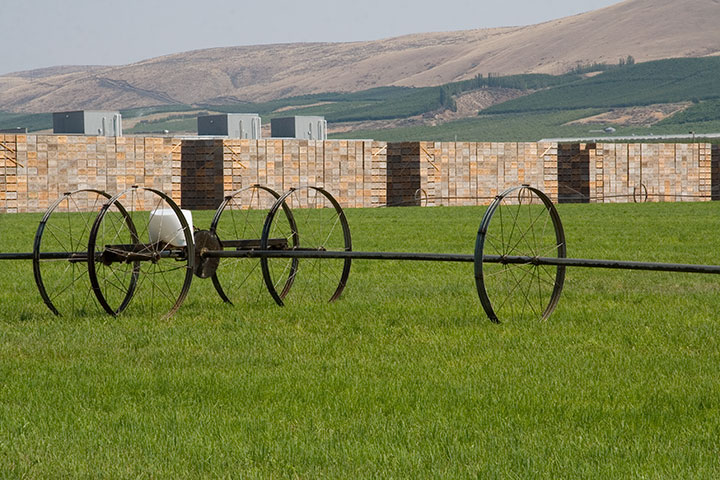
At this time of year, the roadsides are piled high with apple crates,
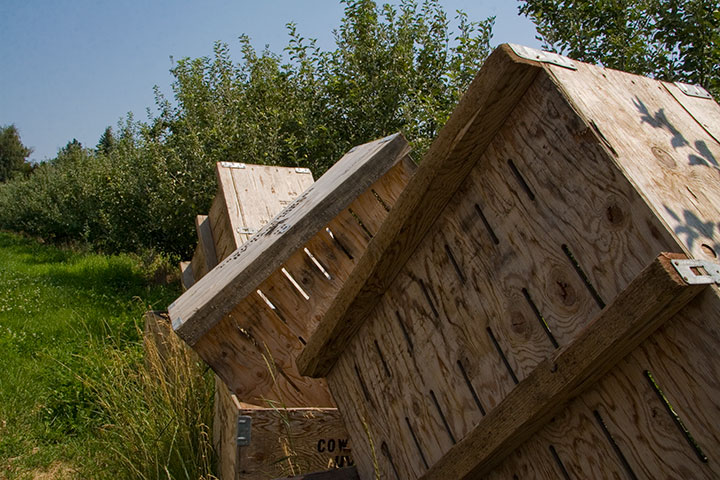
ready for the harvest that will begin in a few weeks.
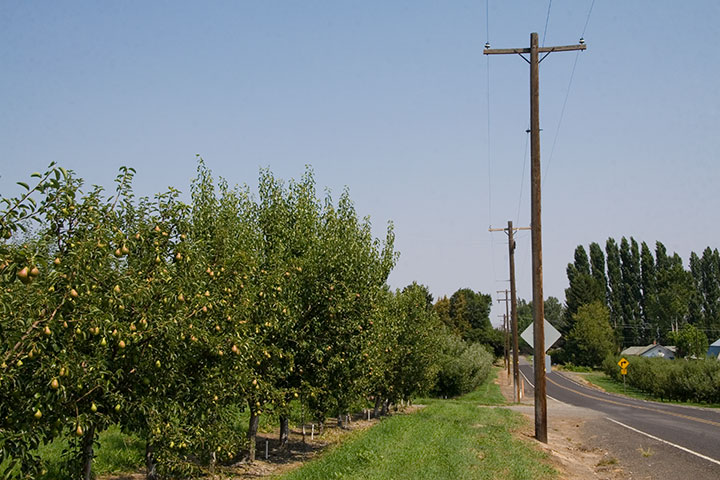
The pears seem to be a little closer—

they’re ripening quite nicely.
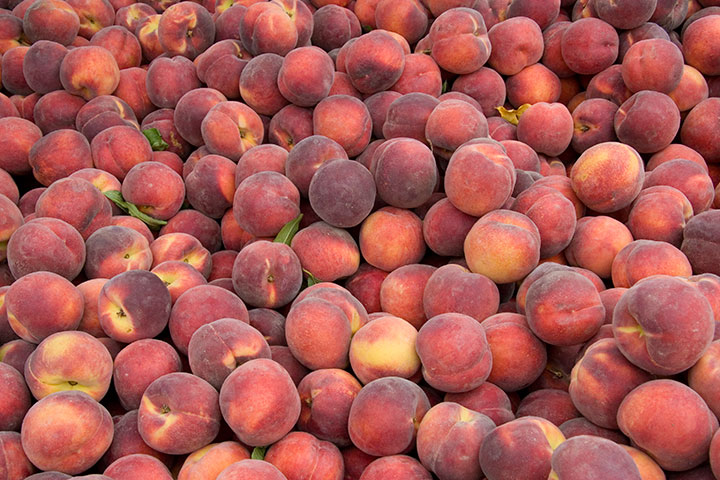
Right now, though, it’s peach season. The Tailor sent us on an errand for as much preserve-ready fruit as we could get our hands on—so I took him literally and brought home fifty pounds of Regina peaches,

another fifty of Rival apricots,
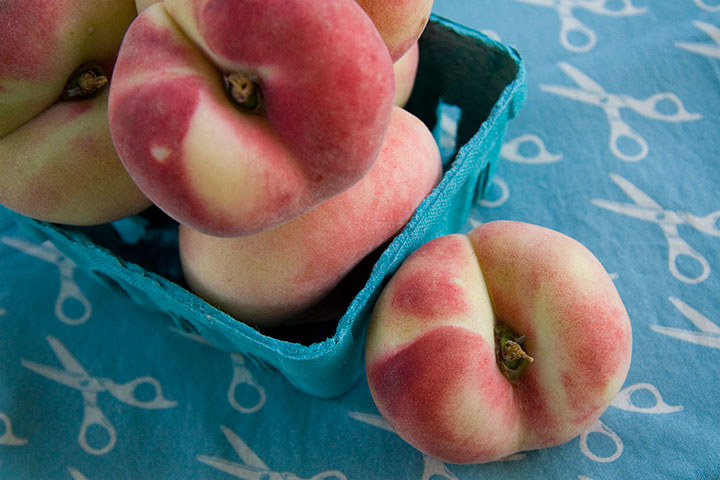
and a handful of beautiful donuts for a snack.
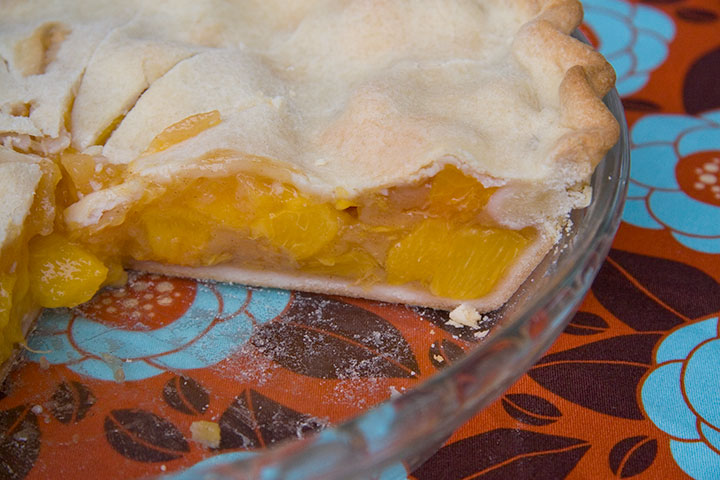
Once he got over his shock at the trunk full of fruit, and set aside a few peaches for the pie I had been begging for, the Tailor canned up an impressive array of preserves. From top left forward: peach jam; ginger-peach chutney (a collaboration with Jessica); sliced peaches in medium syrup; apricot jam; apricot sauce.
My favorite, and the one I can’t wait to taste with a little kugel:
Apricot Jam
(yield: about 10 half-pint jars)
– 2 quarts (8 cups) crushed, peeled apricots
– 6 cups sugar
Now, I’m not going to go into great detail about the whys and wherefores of home canning now, but if canning’s your thing, this will be old hat for you anyway. If not, and you’d like more specific instructions, I’d suggest our favorite resource: Putting Food By.
Anyway. Wash your jars in hot water (most books will tell you to sterilize them, but that’s what the hot water bath at the end is for). Keep the jars hot in a low oven (if you pour hot jam into cold jars, the glass can shatter), and the lids sterile in boiling water until ready to use.
Combine the apricots and sugar in a large stock pot. Slowly bring to a boil, stirring occasionally until the sugar dissolves. Cook at a rapid boil until thick (when the mixture reaches about 220° F, depending on your preference), about an hour, stirring frequently to prevent sticking or scorching.
When the mixture jells, pour it into the hot jars, leaving a 1/4-inch headspace in each. Wipe the jar rims with a clean cloth (any jam left on the rim will prevent the jar from sealing), attach lids, and tighten ring bands. Process in a boiling water bath for 5 minutes (longer if you live at high altitude).
Let cool for 12 hours before removing the ring bands. Store in a dark, dry, cool place.
(Or, if you just can’t wait, pop open a jar and have some toast ready.)

October 22nd, 2009

If you had seen our back porch last weekend, you’d probably think we were starting our own farmers market. But this is a typical sight for many seasonal foodies like us; when you swear off strawberries in January, you need enough fresh autumn fruits and veggies to last you until the end of April (notwithstanding my usual February freak-out where I cave in to a craving or two for salad).
We still have quite a ways to go yet, but we’re working hard to fill our root cellar, attic, freezer and pantry shelves with a wide variety of staples and goodies to keep our winter diet interesting. Here’s what we’ve got so far:
In the root cellar:
– 20 lbs. onions
– 10 lbs. apples (still need 2 bushels)
– 10 lbs. potatoes (still need at least 80 lbs., plus a bushel of carrots and parsnips)
– 9 bottles of wine
In the freezer:
– 4 lbs. locally cured, nitrate-free bacon
– 5 whole, local “Rosie” chickens
– various cuts of local, organic meat
– various cuts of venison, provided by my father-in-law
In the refrigerator:
– 5 lbs. fresh cranberries (for canning; more to come)
– 2 or 3 red cabbages
– 6 or so honeycrisp apples (which don’t keep long but are my favorite kind)
– 1 bunch celeriac root now in my belly—yum!
– 1 lb. garlic
In the pantry:
– 25 lbs. rolled oats
– 5 lbs. steel-cut oats
– 10 lbs. coarse-ground grits (not local, obviously, but the mill is definitely a mom n’ pop operation)
– at least 6 different kinds of rice
– 30 lbs. sugar (mostly for canning)
– 3 quarts local, single-source honey
– 15 or so different varieties of loose-leaf tea
The Tailor’s 2009 home preserving yield to date:
– 5.5 quarts dried blueberries
– 6 pints blueberry syrup
– 5 pints canned whole blueberries
– 9 pints blueberry jam
– 9.5 pints blackberry jam
– 8.5 pints raspberry jam
– 6 pints strawberry jam
– 15 pints canned heirloom tomatoes
– 16 pints tomato sauce
– still to come: apple butter, apple sauce, cranberry sauce, chicken broth

And then there’s the winter squash in the attic: one of my favorite parts of the season, and of living and eating in the Pacific Northwest.
In the attic:
– 14 sugar pie pumpkins
– 8 kabocha squash
– 7 delicata squash
– 6 carnival squash
– 7 acorn squash
– 6 butternut squash
– 3 spaghetti squash
– 1 mini hubbard squash
– 1 jarrahdale pumpkin
Okay, we might have gone a little overboard on the squash, but I never get tired of it, and it’s an important staple of a seasonal diet. We keep these babies in the attic because they last much longer there—pumpkins and squash prefer a cool, dry environment to the cool humidity of the cellar. Our squash colony is a big conversation piece, and we get a lot of questions about pumpkin storage, so I’ll share the scoop:
First, choose squash and pumpkins with intact stems—those that have had their stems snapped off won’t last long. Next, make sure your squash was harvested before the first hard freeze; post-freeze specimens rot fast. Check around the stem and on the bottom end for any mold, rot, blemishes, damage, or sogginess. Now it’s time to sock them away—an attic is best, but anywhere that’s cool, dry and dark will work fine (but never let them freeze! During a cold snap last year we had to haul them all down into the living room when the attic hit 32 degrees!). Don’t stack your squash; just like apples, a rotten squash can infect any neighbors it touches. Instead, we make little “nests” for them by crumpling up newspaper and cushioning each one individually, in a single layer. As long as they’re unblemished and in good shape, and stored carefully, many varieties will last until at least March. Spaghetti squash will often keep until April, but sadly, butternut (my absolute favorite) tends to have the shortest lifespan. So eat those first, and relish every bite.
I feel like a little pumpkin pie. How about you?
October 11th, 2009

Autumn is, hands-down, my favorite time of year. So many of the things I love about fall have to do with food (mulled cider, pumpkin pie, spiced apples, butternut squash, fried green tomatoes, celeriac—the list goes on and on), and since the Tailor and I eat as seasonally and locally as we can, it’s a darn good thing we live in a state with such abundant produce at hand.
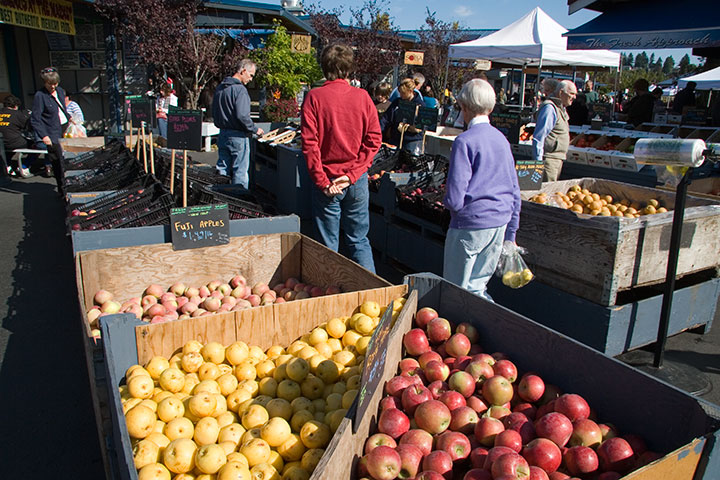
Both T-town and Seattle have incredible open-air markets (hello, Pike Place? I love you.), but my favorite of all is the quietly-unassuming Olympia Farmers Market. Our state capital might not be the hoppin’ tourist hub that downtown Seattle is, but Olympia’s gigantic, spectacular market is one of the best I’ve ever seen, anywhere.
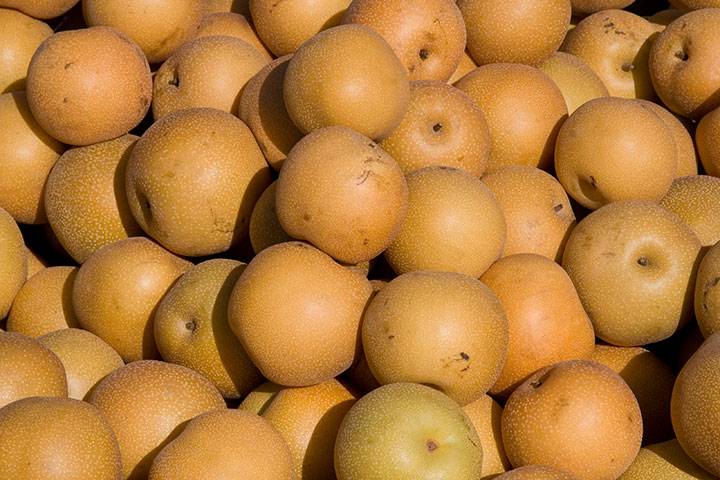
This is the place where you can find around forty different types of Washington apples, and another dozen or so kinds of pears (above are Asian pears, which count as honorary apples in my book).
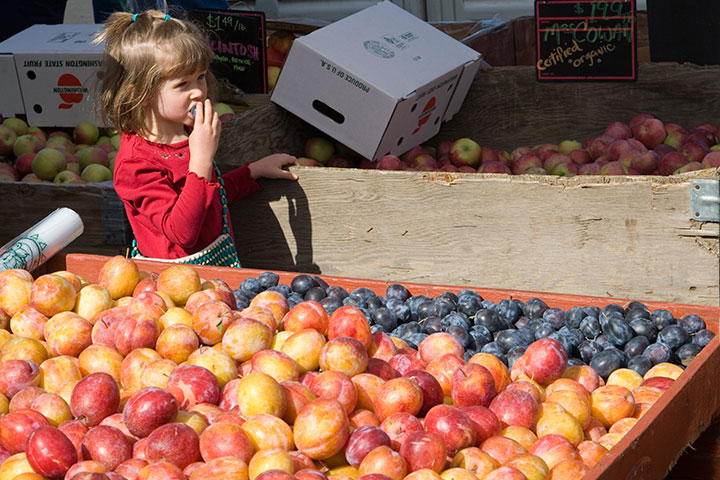
And there’s plenty of everything else, too. The sheer variety is staggering, and distracting—especially when your mission for the day is to buy just one variety of overwintering apples for your root cellar.
Though I must say, I love seeing the transformation from this:

To this:
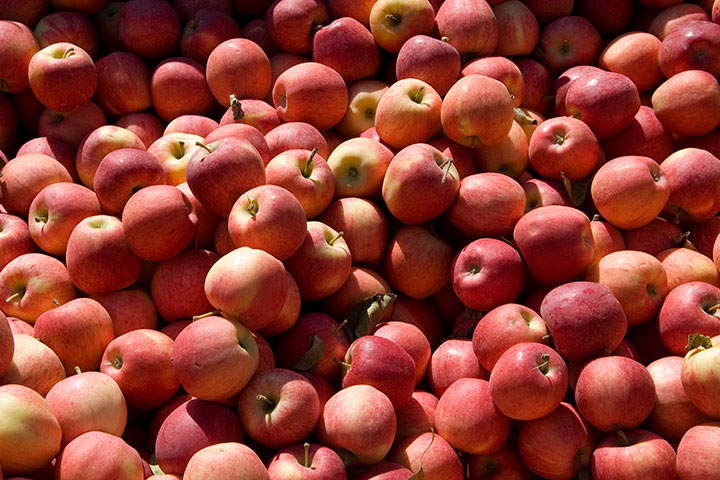
Ingredients for a perfect Sunday: crisp sunny weather, countless apple bins to dig through, a handful of friendly Olympians, and a dash of live bluegrass music for spice.
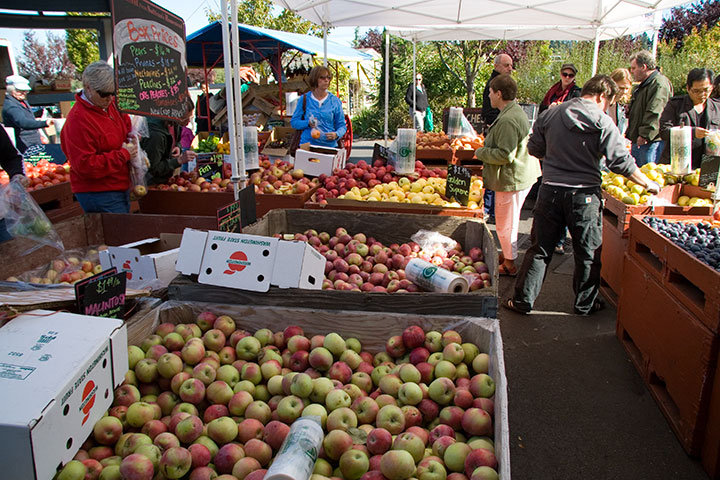
The apples are always a show-stopper, but our biggest goal for the day was something we can’t get at any of the three Tacoma farmers markets:
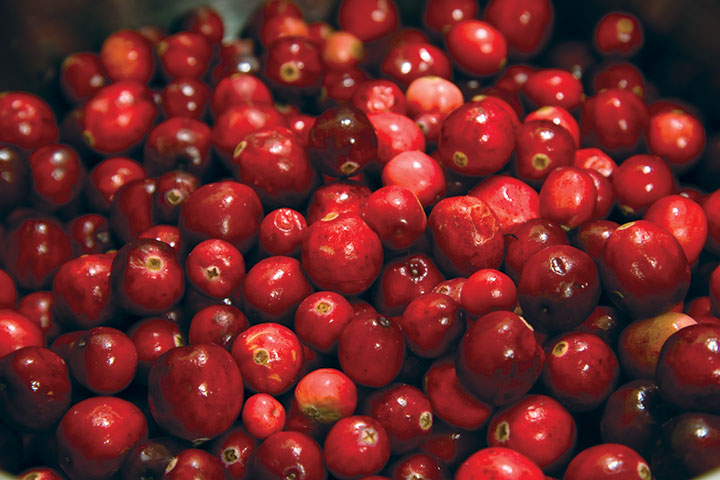
Fresh cranberries. Olympia is the first stop for cranberries coming in from the coast, and the season is now in full swing. We took home just five pounds this time, but you can bet we’ll be back for more. The Tailor and I have a deep and abiding love for cranberry sauce (it’s great on grits. Don’t look at me like that.), and we kicked off this year’s harvest by finishing off the last jar of our 2008 canning crop.
Homemade cranberry sauce is an incredibly easy thing—so much so that I really don’t understand why so many recipes call for Jello. Cranberries have so much natural pectin in them that with enough sugar they’ll jell on their own. In any event, the Tailor and I believe that cranberry sauce should be a sauce, not a can-shaped cylinder of jelly. So in honor of those little rubies from our rugged coast, here is our favorite recipe:
Cranberry sauce
– 1 lb. fresh cranberries, washed and drained
– 2 c. water
– 1 1/2 c. sugar
Combine the water and sugar and bring to a boil in a small saucepan. Boil for about two minutes on high before stirring in the cranberries. Put the lid on and listen; when the cranberries start popping like crazy and the sauce has begun to foam up, it’s done. This takes less than five minutes. Serve hot or cold (or on grits!).
Note: remember to put that lid on, or you’ll have hot, popping cranberries everywhere!
September 13th, 2009
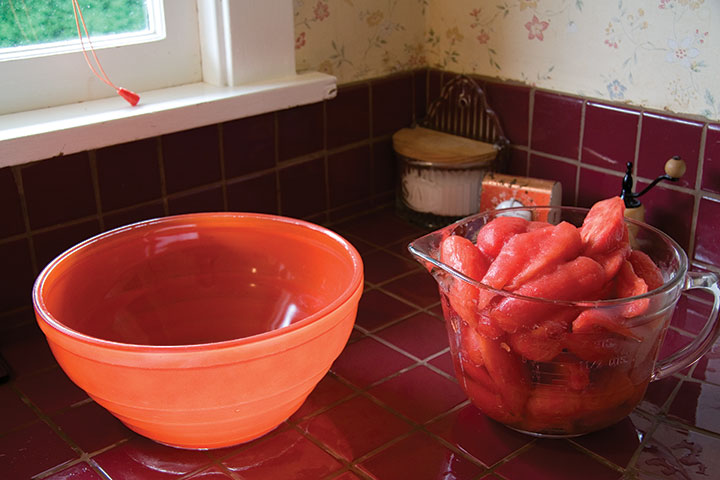
The season is turning ’round these parts—it seems the whole world is tinged with hints of red and gold. We had another warm weekend, but I’m not fooled; behind the hot sun are chill mornings and the rush of the harvest.
So it was another canning weekend for the Tailor, supplied by our latest farmer’s market haul and our final trip to the Blueberry Park for the year. We had to work hard for it yesterday, but amongst the nearly-spent, now-crimson bushes, we found just enough berries for one more batch of jam. Our total haul for the year? Over fourteen gallons of blueberries! In the spring we’ll return the favor by volunteering.
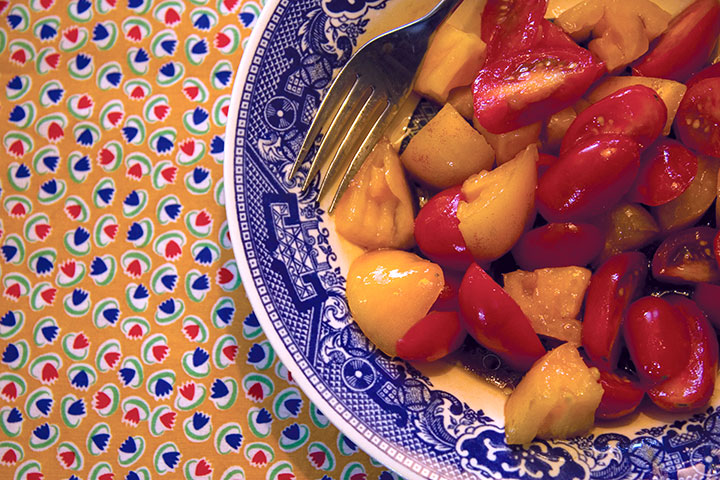
There’s no time to pine for berry season, though—now we’re up to our eyeballs in heirloom tomatoes (like these beauties from our favorite farm in the Puyallup Valley, splashed with a little oil and balsamic). And soon it’ll be time to get the root cellar and attic ready for a winter’s worth of squash, onions, potatoes, and pumpkins (more on that later). Marking transitions is my favorite part of eating seasonally, and autumn is my favorite time of year. I’ll be ready for fall’s bounty—camera in one hand, fork in the other.
August 31st, 2009
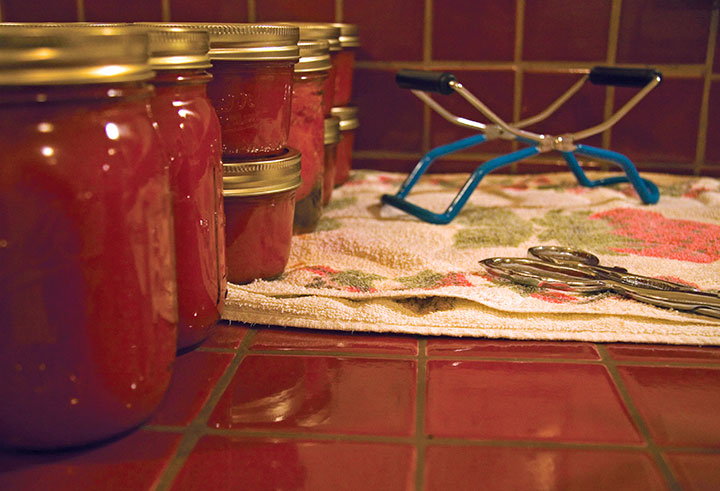
Here at Chez Anagram we’ve got some serious sketching, sewing, stamping, sawing, stirring, scribbling, and, well, scrambling goin’ on. So this is just a quick gasp of air at the surface before I dive back in.
I’ve got a few things to show and tell, but they need a little tweaking first. In the meantime, I’ve finally found something that goes with our scarlet-tile countertops. Just thought I’d share.
See you soon.
July 22nd, 2009

Maybe I’m still not over the shock of moving from Zone Two to Zone Eight, but the sheer variety of fresh produce ’round these parts never ceases to amaze me. Now, if I can barely contain my excitement over what I see at the farmer’s market every week, you can imagine the heart attack I had when the Tailor and I discovered Tacoma’s very own Blueberry Park.
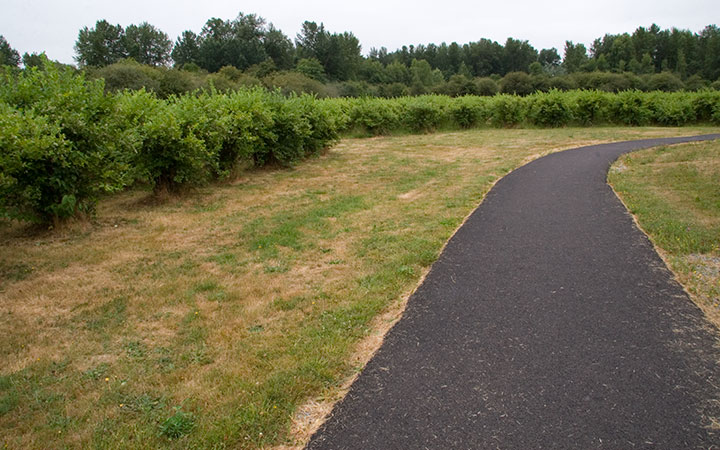
That’s right: a public park. Filled to the brim with blueberry bushes. Four thousand of them. Once upon a time this was a working blueberry farm—after the farm folded or moved on, the land sat vacant and overgrown for years. Eventually Metro Parks took over the land, and decided to free the sixty-year-old bushes from the bracken.
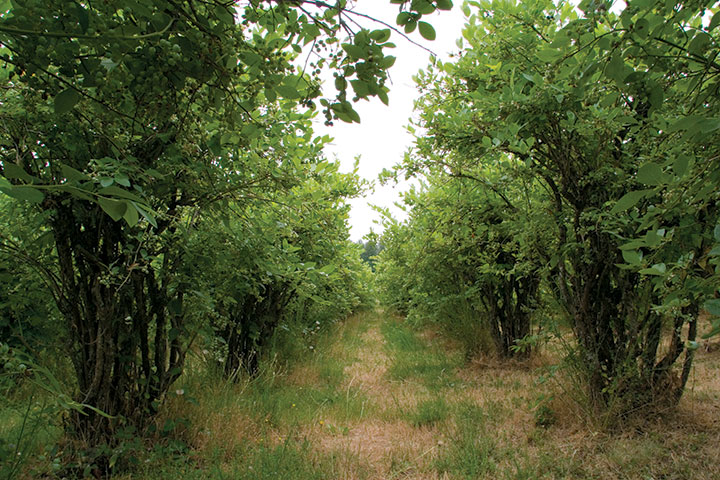
It took years of volunteer labor and many passes by a goat herd to hack back (or eat, depending on one’s preference) the scotch broom and blackberry vines. Now, though, the jungle is mostly kept at bay, and the result is an incredible bounty of pesticide-free berries. The best part? The pickin’ is free. Yes—all the fresh blueberries you, or I, or anyone and their maiden aunt can possibly pick, as many times as we like, for free. And with 4,000 bushes, there’s more than enough to go around. Talk about your tax dollars at work.

The Tailor and I woke up before the sun today for our third berry-picking session. Our two previous trips to Blueberry Park didn’t yield much, as we were a little early for blueberry season. Today, though, an impressive crop was ready to take home, so with metal pails in hand, we dove right in.
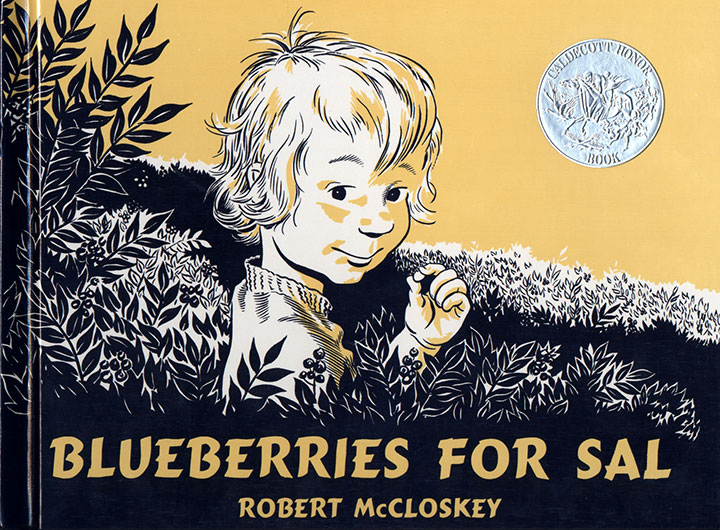
The sound of those first berries hitting the bottom of my pail—kerplink, kerplank, kerplunk—reminded me of one of my favorite children’s books of all time.
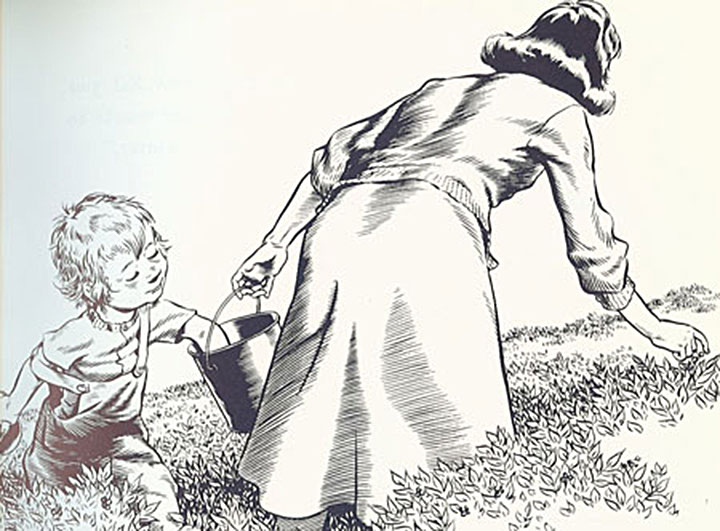
Since we had big plans for these berries, we made sure to arrive with a full stomach.
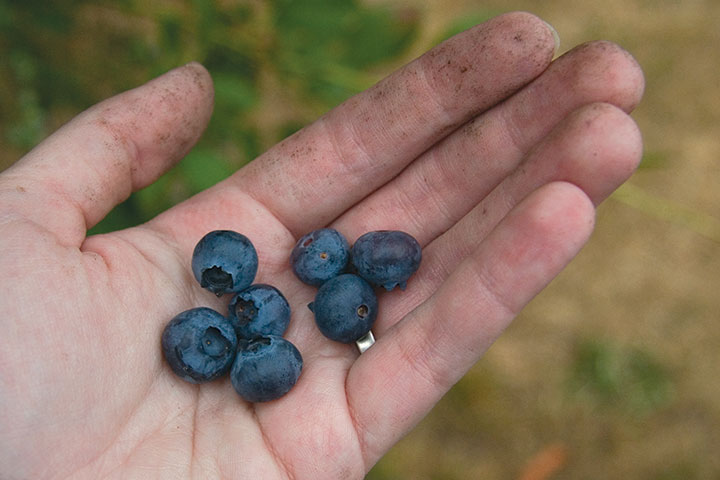
Well, alright, I did eat a few (even with my dirty hands).
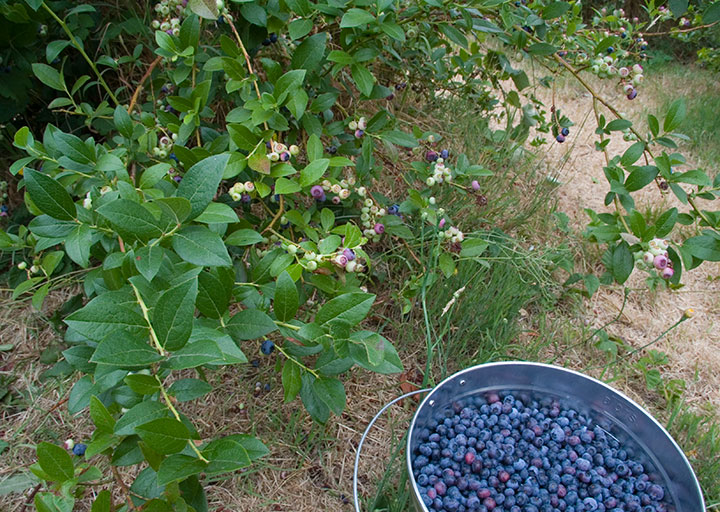
This is the yield of three hours’ work.
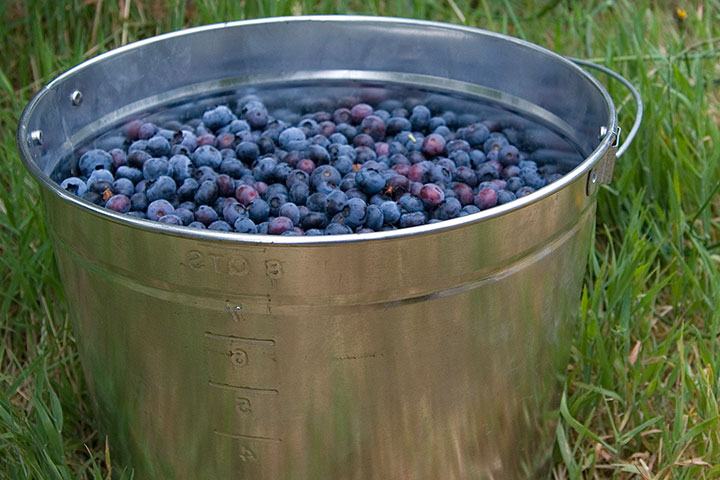
That’s a two-gallon bucket, mind you. We don’t mess around!

Our ultimate goal? The same as Sal’s mum: winter preserves. After all, if you’re a seasonal foodie, the only way to indulge a January craving for berries is to pop open one of your home-canned mason jars.
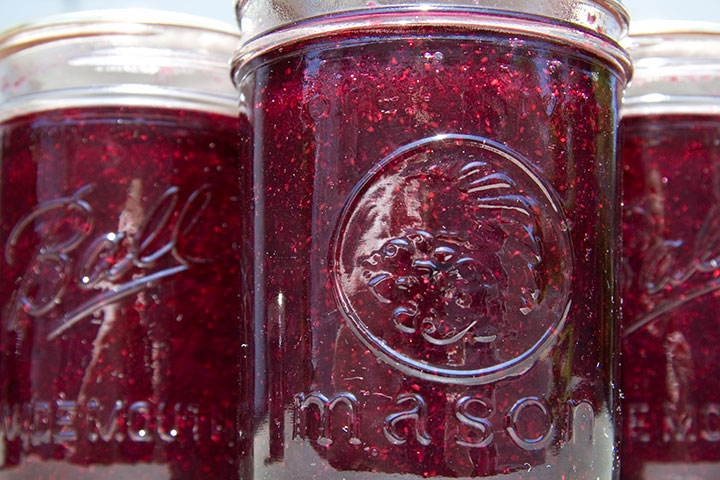
This sparkling jam, yielded by just four quarts of berries, is only the beginning.
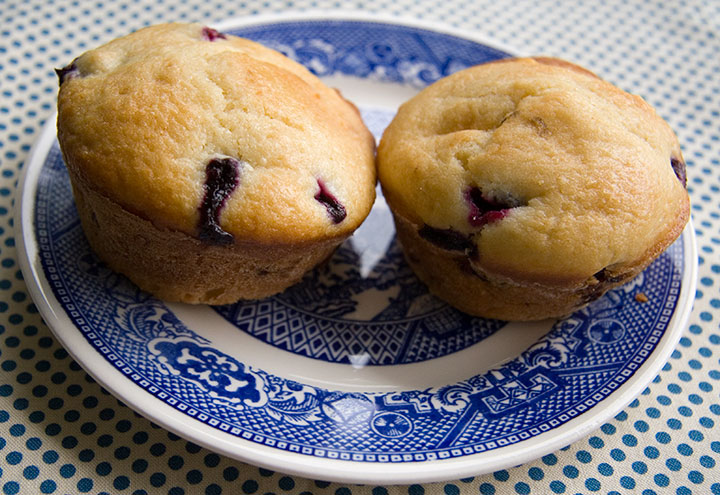
Our house is filled with the scent of baking and the excitement of so many possibilities—pies, pancakes, syrup, glazes, dried berries. What would you do with all the berries you can pick?

Grab a pail, head to south Tacoma, and find out.

![Chandler O'Leary [logo]](https://chandleroleary.com/wp-content/themes/chandleroleary/images/logo.png)



















































